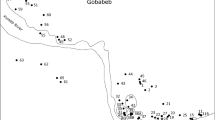Summary
Worker and queen samples of the Argentine antIridomyrmex humilis were analysed using allozyme electrophoresis. Two loci,peptidase andglucosephosphate isomerase, were found to be stainable and polymorphic. Both revealed an estimated relatedness in nestmate females that was close to zero, which is a consequence of the strong polygyny in this species. The inbreeding coefficient was found to be close to zero, which can be explained, in spite of intra-nest mating taking place inI. humilis, by the high mobility of mated queens.
Similar content being viewed by others
References
Benois, A., 1973. Incidences des facteurs écologiques sur le cycle annuel et l'activité saisonnière de la fourmi d'ArgentineIridomyrmex humilis (Mayr) (Hymenoptera, Formicidae), dans la région d'Antibes.Ins. Soc. 20:267–296.
Boomsma, J. J., A. H. Brouwer and A. J. van Loon, 1990. A new polygynousLasius species (Hymenoptera; Formicidae) from central Europe. II. Allozymatic confirmation of species status and social structure.Ins. Soc. 37:363–375.
Crozier, R. H., P. Pamilo and Y. C. Crozier, 1984. Relatedness and microgeographic genetic variation inRhytidoponera mayri, an Australian arid-zone ant.Behav. Ecol. Sociobiol. 15:143–150.
Harris, H. and D. A. Hopkinson, 1978.Handbook of enzyme electrophoresis in human genetics. Elsevier/North Holland biomédical press, Amsterdam, 358 pp.
Kaufmann, B. and L. Passera, 1991. Première approche du problème de la reconnaissance coloniale chezIridomyrmex humilis (Formicidae; Dolichoderinae).Actes Coll. Ins. Soc. 7:75–82.
Keller, L., 1988. Evolutionary implications of polygyny in the Argentine ant,Iridomyrmex humilis Mayr (Hymenoptera: Formicidae): an experimentaly study.Anim. Behav. 36:159–165.
Keller, L., L. Passera and J. P. Suzzoni, 1989. Queen execution in the Argentine ant,Iridomyrmex humilis.Physiol. Entomol. 14:157–163.
Loon, A. J. Van, J. J. Boomsma and A. Andrasfalvy, 1990. A new polygynousLasius species (Hymenoptera; Formicidae) from central Europe. I. Description and general biology.Ins. Soc. 37:348–362.
Marchal, P., 1917. La fourmi d'Argentine (Iridomyrmex humilis Mayr).Bull. Soc. Et. Vulg. Zool. Agric. Bordeaux. 16:23–26.
Markin, G. P., 1970. The seasonal life cycle of the Argentine antIridomyrmex humilis (Hymenoptera: Formicidae), in southern California.Ann. Entomol. Soc. Am. 63:1238–1242.
Newell, W. and T.C. Barber, 1913. The Argentine ant.USDA Bur. Entomol. Bull. 122:98 pp.
Pamilo, P., 1982. Genetic population structure in polygynousFormica ants.Heredity. 48:95–106.
Pamilo, P., 1984. Genotypic correlation and regression in social groups: multiple alleles, multiple loci and subdivided populations.Genetics. 107:307–320.
Passera, L., L. Keller and J. P. Suzzoni, 1988. Control of brood male production in the Argentine antIridomyrmex humilis Mayr.Ins. Soc. 35:19–33.
Passera, L. and L. Keller, 1990. Loss of mating flight and shift in the pattern of carbohydrate storage in sexuals of ants (Hymenoptera: Formicidae).J. Comp. Physiol. B. 160:207–211.
Peacock, A. D., D. W. Hall, I. C. Smith and A. Goodfellow, 1950. The biology and control of the antMonomorium pharaonis (L.).Misc. Publ. Depart. Agri. Scotland. 17:51 pp.
Petersen, M. and A. Buschinger, 1971. Das Begattungsverhalten der PharaoameiseMonomorium pharaonis L.Z. Ang. Ent. 68:168–175.
Ross, K. G., E. L. Vargo and D. J. C. Fletcher, 1987. Comparative biochemical genetics of three fire ant species in north America, with special reference to the two social forms ofSolenopsis invicta (Hymenoptera: Formicidae).Evolution. 41:979–990.
Skaife, S. H., 1955. The Argentine ant,Iridomyrmex humilis Mayr.Trans. Roy. Soc. South-Africa. 34:355–377.
Ulloa-Chacon, P. and D. Cherix, 1988. Quelques aspects de la biologie deWasmannia auropunctata (Roger) (Hymenoptera, Formicidae).Actes Coll. Ins. Soc. 4:177–184.
Wilson, E. O., 1971.The Insect Societies. Cambridge, Mass. Belknap Press, Harvard Univ. Press, 548 pp.
Yamauchi, K., K. Kinomura and S. Miyake, 1981. Sociobiological studies of the polygynic antLasius sakagamii. 1. General features of its polydomous system.Ins. Soc. 28:279–296.
Author information
Authors and Affiliations
Rights and permissions
About this article
Cite this article
Kaufmann, B., Boomsma, J.J., Passera, L. et al. Relatedness and inbreeding in a French population of the unicolonial antIndomyrmex humilis (Mayr). Ins. Soc 39, 195–200 (1992). https://doi.org/10.1007/BF01249294
Received:
Revised:
Accepted:
Issue Date:
DOI: https://doi.org/10.1007/BF01249294



